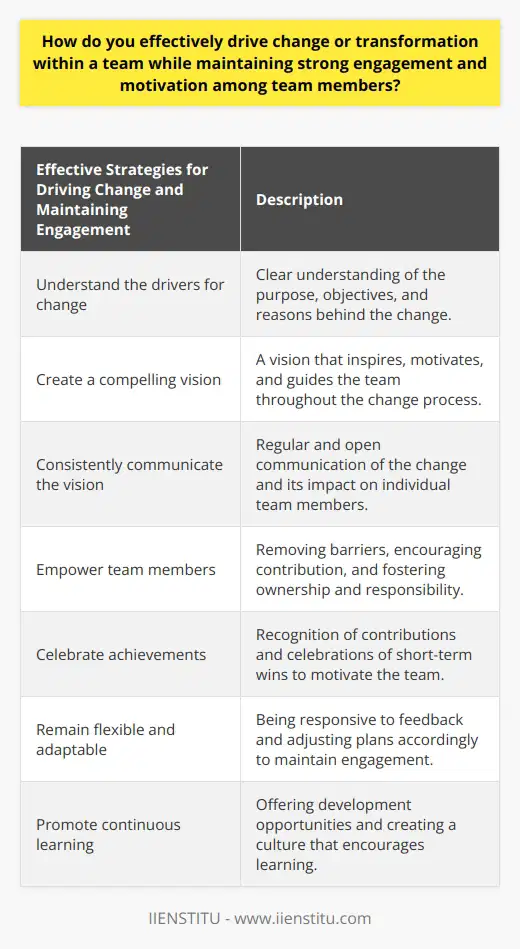
Examining the Challenges of Change
Developing a Plan to Overcome Resistance
Creating an Open and Collaborative Environment
Effectively Communicating with People Affected by Change
Change is an integral part of business, and to remain competitive, it is vital that organizations can drive transformation and overcome any resistance to change.
This blog post will discuss how to drive transformation and how organizations can successfully implement change and overcome any resistance they may encounter.
Examining the Challenges of Change
Change brings its own set of challenges, and resistance is a natural part of the process. It is essential for organizations to understand the different motivations for resistance and to recognize that each individual may have different levels of resistance to the changes that the organization is attempting to drive. In some cases, political or organizational barriers to change may make it more challenging to implement the desired changes. It is also essential to recognize that not all resistance is negative. It can be a valuable tool to help understand problems that may arise when implementing a new change.
Developing a Plan to Overcome Resistance
Once the resistance areas have been identified, organizations must develop strategies to address them. Again, involving stakeholders in the process ensures that potential issues are identified and addressed early. The organization should also create clear plans and goals to help guide the transformation and ensure everyone is working towards the same objectives.
Creating an Open and Collaborative Environment
To be successful in driving transformation, organizations must create an open and collaborative environment in which it is safe for people to express their opinions. Ensuring everyone is heard, and their views are respected and valued is essential. This can create a culture of openness that encourages dialogue and helps overcome resistance.
Unlocking Transformation: A Comprehensive Overview of Change Management
Uncovering the Real Org Chart: Who Has the Power in Leadership?
Effectively Communicating with People Affected by Change
It is also essential for organizations to effectively communicate with people affected by the changes that are being driven. Organizations must ensure that everyone is kept up to date on developments and have the opportunity to provide feedback. This will help people understand the changes and how they may be affected.
In conclusion, organizations must develop a plan to drive transformation and overcome any resistance to change that they may encounter. This includes identifying areas of resistance, designing strategies to address them, creating a supportive environment where people feel safe to express their opinions, and effectively communicating with people affected by the changes. By taking these steps, organizations can successfully drive transformation and achieve the desired changes.
Driving transformation takes hard work and commitment, but the rewards are worthwhile.

Frequently Asked Questions
What strategies are effective for addressing resistance to driving change?
Organizations must continually transform to remain competitive and grow, yet change initiatives often fail due to individual and organizational resistance. To address this issue, organizations need to develop and implement effective strategies to manage resistance to driving change. There are various strategies designed to counter opposition to driving change, including:
Engaging Connected Stakeholders: It is essential to ensure that all stakeholders affected by the planned change are adequately involved throughout the process. This includes actively listening to the stakeholders, understanding their concerns, and incorporating their feedback into the change initiative. It is essential that the stakeholders feel involved, valued, and respected.
Facilitating Open Communication: Open and ongoing communication is essential to helping stakeholders understand the change initiative's purpose, need, and impact. This will help stakeholders become more receptive to the change and its potential benefits.
Providing Evidence to Back Up the Change: It is essential to provide evidence to back up the proposed change to demonstrate that it is necessary and will benefit the organization. This could include data, case studies, best practices, benchmarking, and surveys.
Establishing Processes and Structures for Implementation: Establishing processes and structures for implementing the change initiative is critical. This will help ensure all stakeholders work towards the same goals and objectives.
Ensuring Accountability and Visibility: Accountability and visibility are essential for successful change initiatives. Therefore, ensuring that those responsible for leading, driving, and implementing the change are accountable for their tasks and success is vital. This will also help to create a sense of trust and ownership amongst stakeholders.
Offering Appropriate Training, Support, and Resources: It is essential to ensure that those affected by the change have access to appropriate training, support, and resources to ensure that they can adjust to and implement the change.
Organizations can increase their chances of success by developing and implementing an effective change management strategy by addressing resistance to driving change.
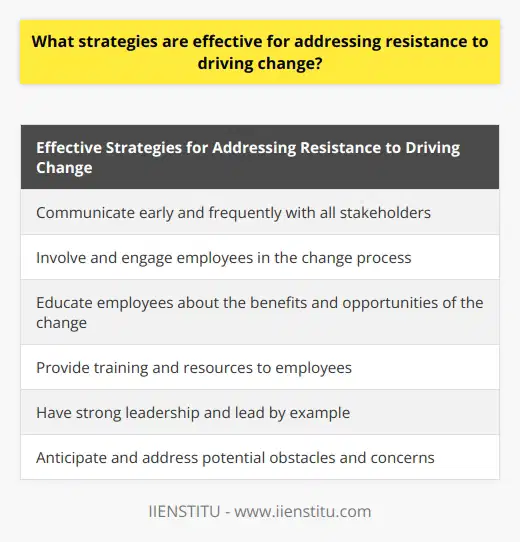
What factors should be considered when developing a strategy for driving transformation?
It is essential to consider several factors when developing a strategy for driving transformation. First, there must be an understanding of the current organizational and individual capabilities so that the right mix of people, processes, and technology can be utilized to drive the transformation.
First and foremost, organizations must assess their capabilities. This includes understanding what resources, such as finances, technology, and staff, are available to execute the transformation. Organizations must also evaluate their organizational capabilities, such as their culture, processes, and structure. These capabilities will determine which change initiatives must be taken and how they should be executed.
Organizations must also assess the capability of their personnel. This assessment should include each individual's skills, knowledge, and attitudes. Knowing the capabilities of their personnel will aid in resource allocation and identify gaps in knowledge and equipment, allowing organizations to develop strategies for filling those gaps. Additionally, personnel evaluations should include an assessment of employee motivation, engagement, and potential for development.
Once the capabilities assessment is complete, planning and implementing the transformation strategy should take place. This requires organizations to build a plan outlining the steps, activities, and procedures for achieving their desired outcomes. Organizations must also develop a governance model, decision-making framework, and a timeline for executing each transformation initiative.
A technology assessment should also be included in the transformation strategy. Organizations must assess their current technology landscape, identify areas of improvement, and define requirements for future technology. In addition, organizations should consider the capabilities of the existing tech stack and the implications of new technologies, and how they might impact their transformation strategy.
Finally, organizations must develop an internal communications plan to ensure every stakeholder is on the transformation journey. This includes building a communications strategy that outlines how the information will be shared internally, with customers, and with other stakeholders. Effective communication will enable organizations to maintain trust and commitment to their transformation initiatives.
In summary, organizations must consider the organizational and individual capabilities, plan for the transformation strategy, assess the impact of technology, and develop an internal communication plan when creating a system for driving transformation. Organizations will be well-positioned to successfully execute their transformation initiatives by ensuring these factors are considered.
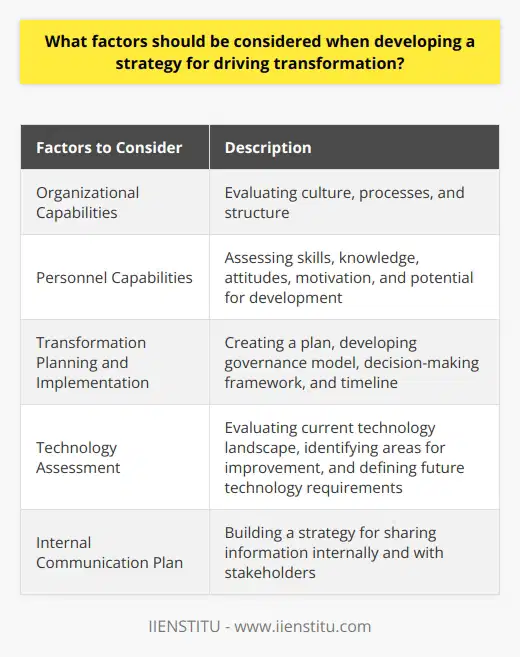
How can organizational culture influence successful implementation of change initiatives?
Organizational culture has a significant impact on the successful implementation of change initiatives. It isn't easy to fully realize the importance of corporate culture and its influence on successfully redirecting an organization's strategies and policies. Still, the effects of a strong and healthy organizational culture on the successful implementation of change initiatives cannot be overstated.
Several elements establish an organizational culture, such as leadership, internal communications, and individual goals. A cohesive culture contributes to successful change initiatives when these components are aligned. In addition, a healthy corporate culture promotes collaboration, open communications, and trust among staff, enabling them to work together to create sustainable change.
The organizational culture also plays a vital role in motivating staff to take the initiative and accept new initiatives. Staff that is motivated and engaged in the conversation are more likely to understand the purpose and significance of changes, which increases the likelihood of successful implementation. A unified and trusting workforce also encourages employees to take risks and innovate, which helps organizations stay competitive.
Organizational culture also influences how well organizations can respond to external industry changes. Companies that are flexible and adaptive to changes in their industry are more likely to implement change initiatives successfully. Furthermore, organizations must be able to adapt to different workflow processes and enable teams to work together to respond to rapidly changing market conditions. A strong organizational culture helps ensure that the organization is prepared for whatever changes or challenges may arise.
In conclusion, organizational culture plays a significant role in successfully implementing change initiatives. Leaders must create a culture of safety, trust, engagement, and collaboration to best support the implementation of new ideas and strategies. Through thoughtful leadership, open communication, and motivating staff, organizations can create a solid organizational culture that sets the stage for the successful implementation of change initiatives.
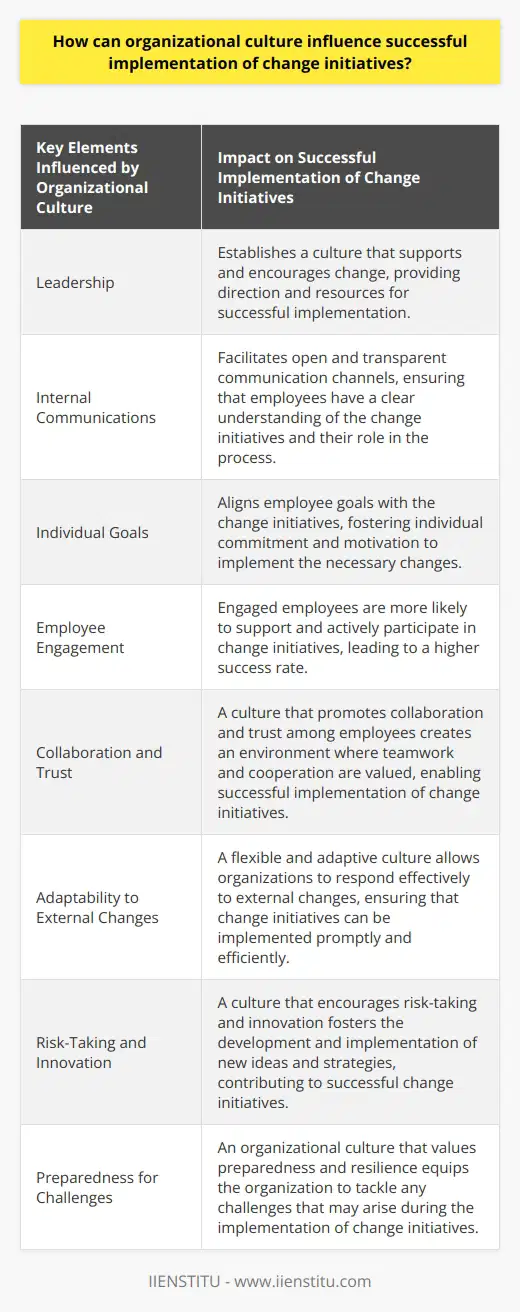
What are the factors that contribute to employee resistance to change and how can they be mitigated?
Factors Contributing to Employee Resistance
Employee resistance to change can occur for numerous reasons, such as lack of communication, fear of job security, and perceived loss of control. Addressing these factors can help companies successfully implement changes, thus maintaining efficiency and productivity in the workplace.
Lack of Communication
One major factor contributing to employee resistance is inadequate or poor communication. Ambiguity regarding the reasons behind the change and its potential impacts on employees can generate anxiety and skepticism. To mitigate this factor, organizations must be transparent about the reasons for change, and its potential benefits for employees. Clear communication on the objectives of the change, the expected timeline, and steps to be taken during the transition can minimize resistance and ensure a smoother implementation process.
Fear of Job Security
Another factor contributing to resistance is the fear of losing job security or facing new responsibilities. Employees may resist change if they perceive it as a threat to their employment or stability. To address this concern, organizations can involve employees in the decision-making process and provide avenues for open discussions about their concerns. This fosters trust and builds rapport, making the employees more receptive to change.
Perceived Loss of Control
Perceived loss of control results from employees feeling disempowered or having limited mastery over the change process. This can hinder the ability to adapt to new processes or technologies. To tackle this issue, companies can provide employees with adequate training, resources, and support. This would empower them to effectively adapt to new changes and maintain confidence in their capabilities.
Effect of Organizational Culture
The prevailing organizational culture plays a significant role in determining employee resistance to change. In a supportive and cooperative environment, resistance to change may be less, as employees are more willing to collaborate and adapt. Management must strive to foster a positive culture, emphasizing adaptability, flexibility, and continuous learning to reduce resistance to change.
Conclusion
In summary, addressing factors such as lack of communication, fear of job security, perceived loss of control, and organizational culture can significantly reduce employee resistance to change. Companies must be transparent, involve employees in decision-making, provide adequate training, and foster a supportive culture to successfully implement changes and maintain productivity in the workplace.
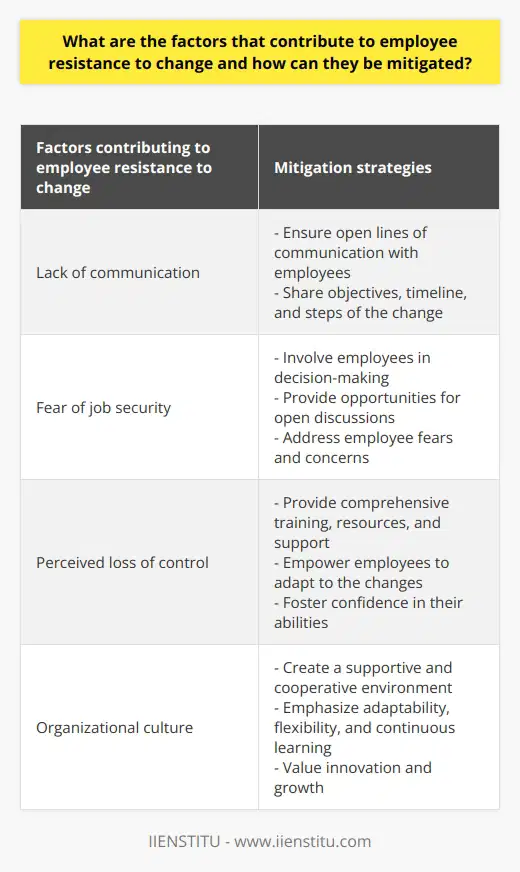
How do different communication styles and techniques impact the success of change management efforts?
Understanding Communication Styles in Change Management
The significance of effective communication in change management cannot be overstated, as it drives success in the adoption of new strategies and operations. Different communication styles and techniques greatly influence the outcomes of change initiatives, particularly in the stages of planning and execution.
Role of Communication Styles
Distinct communication styles, such as assertive, passive-aggressive, aggressive, and passive, have varying impacts on the workforce during organizational shifts. Assertive communication, for example, fosters an environment where team members feel valued and confident in expressing their opinions, leading to enhanced engagement and buy-in from employees. In contrast, aggressive or passive-aggressive styles can result in resistance or lack of collaboration, compromising the efficiency of change implementation.
Choosing the Right Techniques
Selecting the appropriate communication techniques ensures that employees are adequately informed and can smoothly transition during change processes. Face-to-face discussions, presentations, and workshops facilitate deeper understanding and enable staff to ask questions and provide feedback. Moreover, using multiple communication channels, such as email, intranet updates, and team meetings, increases accessibility and comprehension of information. Tailoring the technique to the target audience and the nature of the change further amplifies the effectiveness of the message being delivered.
Feedback and Listening
Encouraging feedback and actively listening to employees' concerns play a crucial role in change management success. By engaging in two-way communication, leaders can address potential misunderstandings and provide clarity. Offering consistent and timely updates can further establish a strong foundation for change while ensuring employees feel supported and recognized.
Cultural Sensitivity
An essential aspect of effective communication in change management is being mindful of cultural differences within the organization. Adapting the communication style to diverse teams enables constructive dialogue, promotes inclusivity, and facilitates the assimilation of changes across the workforce.
In conclusion, understanding and employing different communication styles and techniques significantly impact the success of change management efforts. By adopting an assertive communication style, selecting appropriate techniques, promoting feedback and listening, and considering cultural factors, organizations can effectively manage change and boost the likelihood of achieving desired outcomes.
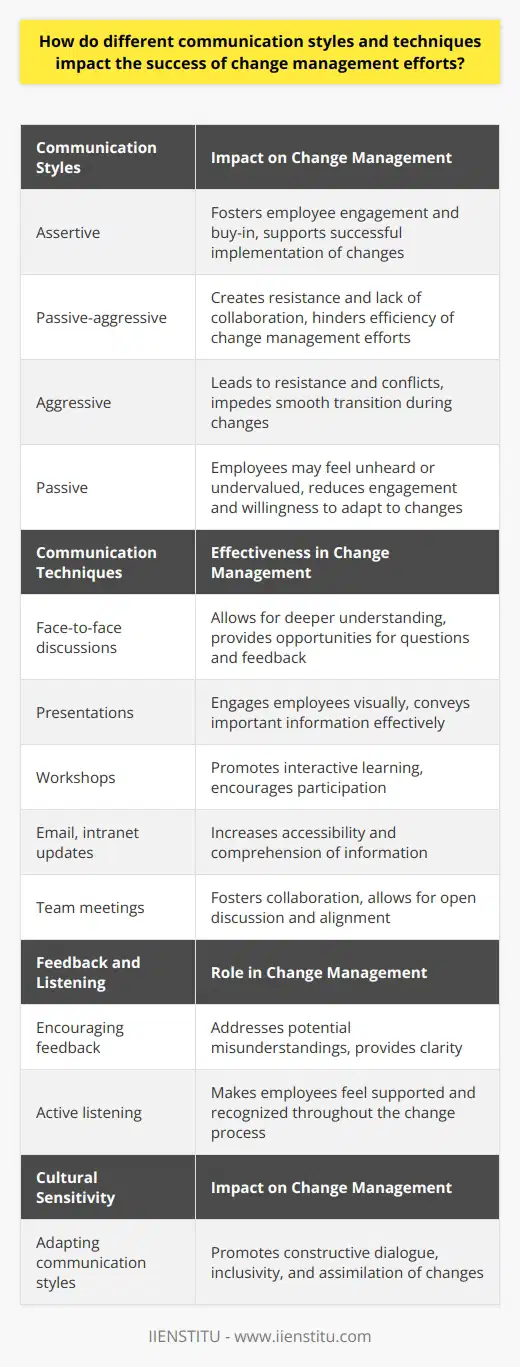
In what ways can leadership play a role in minimizing resistance and fostering a supportive environment for change?
Leadership's Role in Minimizing Resistance
Effective leadership plays a critical role in minimizing resistance and fostering a supportive environment for change. One key aspect is clear communication; leaders must articulate the objectives and benefits of the change, emphasizing the potential positive outcomes for the organization and its members. By providing a strong rationale and demonstrating a deep understanding of the anticipated impact, leaders can address fears, misconceptions, and uncertainties that may impede employees' acceptance of new initiatives.
Building Trust and Inclusivity
Another important aspect of leadership is building trust and inclusivity. Actively involving stakeholders in the decision-making process, soliciting their input, and addressing their concerns can help create a sense of ownership and ensure that their perspectives are considered. Moreover, a participative approach can enhance employees' commitment to change and alleviate the perception that the transformation is being imposed on them.
Emphasizing Learning and Adaptability
Leaders can also minimize resistance by emphasizing the importance of learning and adaptability. By fostering a culture of continuous improvement, encouraging experimentation, and tolerating mistakes, organizations can create an environment that is more conducive to embracing change. This approach enables employees to view change as a natural part of their professional growth and development, rather than a disruption or threat to their existing routines.
Demonstrating Empathy and Support
Empathy and support are also crucial components of leadership during times of change. By acknowledging the challenges, providing emotional support, and offering resources for coping with transitions, leaders can help mitigate the stress experienced by employees. Additionally, timely feedback and recognition of employees' efforts can bolster their motivation and resilience, facilitating a smoother adaptation to the new environment.
Acting as Role Models
Finally, leaders should take the initiative and act as role models for change, embodying the desired behaviors and attitudes. By demonstrating commitment, enthusiasm, and adaptability, they show employees that embracing change is both possible and beneficial for personal and organizational success.
In conclusion, leadership plays a pivotal role in minimizing resistance and creating a supportive environment for change. Through clear communication, trust-building, emphasizing learning and adaptability, and providing empathy and support, leaders can facilitate a smoother change process and guide their organizations toward greater growth and success.

What are the critical components of leadership when managing resistance to change?
Understanding Resistance to Change
The critical components of leadership when managing resistance to change in an organization include effective communication, empathy, trust-building, and proactive planning. These are essential for addressing the concerns and challenges faced by employees and other stakeholders during the change process.
Effective Communication
Clear, transparent, and timely communication from leaders is vital in explaining the rationale behind the change and addressing concerns. Consistent messaging from all management levels is necessary to convey information to all individuals within the organization, thus reducing confusion, anxiety, and potential misinformation.
Empathy and Active Listening
Leaders need to empathize with employees' feelings of uncertainty or loss as they navigate through change. Active listening involves understanding varied perspectives and acknowledging the challenges experienced by various stakeholders to address these issues effectively.
Trust-Building
A strong foundation of trust between leaders and employees allows for smoother implementation of changes. To build trust, leaders should involve employees in the change process, demonstrating genuine care for their wellbeing, and creating a sense of ownership and shared responsibility for the change outcomes.
Proactive Planning
Leaders should be proactive in identifying potential resistance points and creating strategies to address them. Meticulous planning is necessary to minimize disruption, anticipate potential obstacles, and allocate sufficient resources to support those who may struggle with the transition.
In conclusion, effective leadership plays a crucial role in managing resistance to change in organizations. By focusing on communication, empathy, trust-building, and proactive planning, leaders can facilitate a smoother and less stressful change process for all involved. Ultimately, successful change management depends on recognizing and addressing the people-related challenges that invariably accompany organizational transformation.

How can an organization's structure and systems help mitigate individual resistance to new strategic initiatives?
Organizational Structure and Systems
An organization's structure and systems play a crucial role in mitigating individual resistance to new strategic initiatives. Effective implementation of strategic plans largely depends on a well-designed organizational structure that aligns with the overall objectives of the organization.
Clear Communication Channels
One way to overcome resistance is through clear communication channels. Establishing a system of effective communication helps employees understand the reasons behind the new strategy, their role in its implementation, and potential benefits to the organization. This enhances the chances of achieving buy-in from employees and reduces the likelihood of resistance.
Empowerment and Inclusivity
Inclusivity is essential in the implementation of new strategic initiatives. Engaging employees in decision-making processes and providing opportunities for them to contribute ideas and feedback fosters a sense of ownership. This not only eliminates potential resistance but also ensures employees feel empowered and committed to the success of the new strategy.
Adaptability and Flexibility
A flexible and adaptable organizational structure allows for seamless integration of new strategic initiatives into existing systems. Incorporating adaptable structures, such as cross-functional teams, enables organizations to adjust to changes quickly and effectively, reducing employee resistance to fresh initiatives. A well-designed structure that fosters adaptability and flexibility can help businesses seamlessly embrace new strategies.
Training and Development
Organizations can reduce individual resistance by investing in training and development. Providing employees with the necessary skills and knowledge to embrace and execute the new strategy enhances their confidence and willingness to accept change. Furthermore, supporting employees through the transition process can minimize their resistance and promote successful implementation.
Reward and Recognition System
Finally, an organization can use its reward and recognition system to motivate employees to accept and support new strategic initiatives. By linking rewards and recognition to the successful implementation of new strategies, the organization can ensure employees view this adoption as beneficial to their professional growth and success.
In conclusion, an organization's structure and systems are vital in mitigating resistance to new strategic initiatives. By promoting clear communication, empowerment, adaptability, comprehensive training, and a supportive reward system, organizations can minimize individual resistance and encourage buy-in from employees. Implementing these measures can greatly improve the chances of success for new strategic initiatives.

In the context of change management, how can psychological factors of individuals be addressed to reduce resistance to change?
**Understanding Psychological Factors**
To successfully address psychological factors of individuals in change management, it is crucial to first identify and understand the underlying reasons for resistance. Employees may resist change due to fear of the unknown, loss of control, or perceived threats to their job security. By recognizing these fears, managers can better empathize with employees and develop strategies to alleviate these concerns.
**Communication and Transparency**
Clear communication is essential when dealing with psychological factors in change management. Managers should provide timely and accurate information regarding the change and its rationale. Providing employees with a thorough understanding of the reasons for the change and involving them in the decision-making process can help facilitate acceptance and reduce resistance.
**Training and Support**
In addition to communication, providing adequate training and support plays a crucial role in addressing the psychological factors of individuals. Employees may feel overwhelmed by the change, especially if they lack the skills or knowledge to adapt. Providing proper training and resources can help employees feel more comfortable with the changes, ultimately reducing resistance.
**Acknowledging and Validating Concerns**
Managers should actively acknowledge and validate employee concerns to show empathy and understanding. This helps in building trust and developing a positive working relationship between management and employees during the transition. Validation demonstrates that management is sensitive to the issues employees are facing, leading to a more successful change management process.
**Creating a Culture of Adaptability**
Finally, fostering a culture of adaptability can help reduce resistance to change by promoting an environment where change is viewed positively. Encouraging employees to be open-minded, adaptable, and willing to learn new techniques can help create a more flexible workforce. This adaptability prepares employees to embrace and manage change more effectively in the future.
In conclusion, change management can be more successful when psychological factors of individuals are effectively addressed. Taking steps to understand, communicate, provide training and support, validate concerns, and cultivate a culture of adaptability are essential when mitigating resistance to change in work environments.

What are the key principles behind effective change management in an organizational context?
Understanding Change Management Principles
The key principles behind effective change management in an organizational context can be distilled into several fundamental areas. These principles guide an organization as it navigates the complexities and challenges of implementing change while ensuring optimal outcomes for all stakeholders.
Clear Communication and Inclusiveness
One vital principle for change management success is clear, consistent, and transparent communication. This involves clearly articulating the reasons for change, the desired outcomes, and the process through which the change will be implemented. Fostering a sense of inclusiveness by involving employees in the decision-making process can further enhance change acceptance and overall success.
Shared Vision and Alignment
Ensuring that all stakeholders share a common vision and understanding of the change is pivotal for effective change management. This requires a clear definition of the strategic objectives, expected benefits, and the roles and responsibilities of all team members. Alignment between leadership and employees creates a collaborative environment in which everyone can work together towards the common goal of successful change implementation.
Flexibility and Adaptability
Change processes often involve a certain degree of uncertainty and unforeseen challenges. Therefore, embracing flexibility and adaptability is crucial for effective change management. This principle entails regularly evaluating the progress and outcomes of the change initiative and adjusting strategies and tactics as needed. It is essential for organizations to maintain an agile mindset, enabling them to adapt and respond to changing circumstances.
Emphasizing Employee Support and Training
Change initiatives often necessitate new skills or ways of working for employees. Accordingly, providing adequate training and support can significantly increase the likelihood of change management success. This involves offering resources and opportunities for employees to develop and refine the required competencies, ensuring they are fully prepared to implement and sustain the desired changes.
Monitoring and Evaluating Change Outcomes
Finally, effective change management requires ongoing monitoring and evaluation of the change process and its outcomes. Analyzing key performance indicators and collecting feedback from stakeholders enables organizations to assess the effectiveness of change initiatives and identify any areas that may require further modification or improvement. This iterative approach ensures that organizations continually refine and enhance their change management strategies, ultimately maximizing the likelihood of successful change implementation.
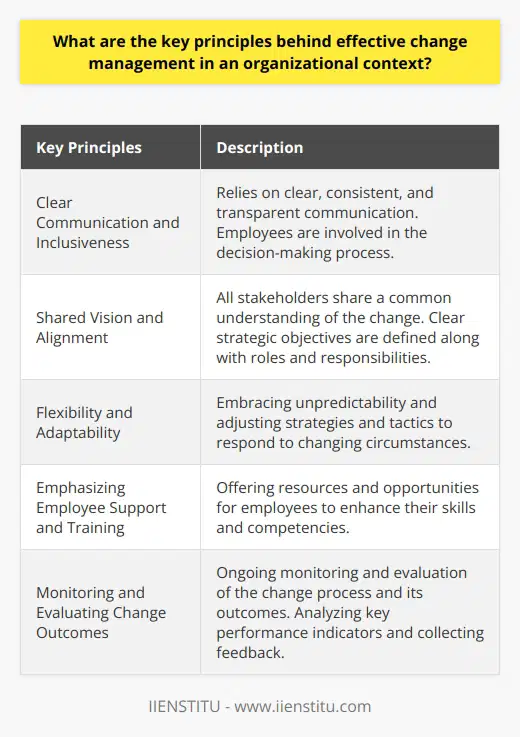
How can leaders ensure employee engagement during periods of substantial change?
Effective Communication
One of the key strategies that leaders can employ to ensure employee engagement during periods of substantial change is effective communication. Clear and timely information about the changes helps in reducing uncertainty and uneasiness among employees. By providing regular updates and establishing open channels for feedback, leaders can foster trust and promote a sense of shared purpose.
Inclusive Decision Making
In addition to open communication, involving employees in the decision-making process can significantly enhance their engagement. When employees feel that their opinions are valued and that they have a role in shaping the change, they are more likely to embrace it and remain committed to the organization. Leaders can encourage participation by soliciting feedback, hosting brainstorming sessions, and creating cross-functional teams to address specific aspects of the change.
Support and Training
During times of change, it is crucial for leaders to provide adequate support and training to help employees adapt to the new reality. This may involve skill development workshops, mentoring programs, or even reassigning some employees to different roles within the organization. By showing empathy and understanding when employees struggle, leaders can cultivate a positive work environment that encourages resilience and problem-solving.
Recognition and Reward
Recognizing and rewarding employees' efforts during periods of change can also contribute to their engagement and motivation. Leaders can express their appreciation for employees' hard work and dedication through verbal praise, written acknowledgments, or tangible rewards such as bonuses or promotions. By celebrating employees' achievements, leaders send a clear message that their contributions in navigating the change are valued and recognized.
Building a Culture of Adaptability
Lastly, fostering a culture of adaptability within the organization can help ensure employee engagement during periods of change. Leaders can do this by modeling flexibility and adaptability in their own behavior, encouraging innovation, and promoting a growth mindset among employees. In such an environment, employees are more likely to embrace change as an opportunity for growth and learning, rather than as a threat to their job security.
In summary, leaders can ensure employee engagement during periods of substantial change through effective communication, inclusive decision making, support and training, recognition and reward, and building a culture of adaptability. By implementing these strategies, leaders can successfully guide their teams through challenging transitions while maintaining high levels of engagement and productivity.
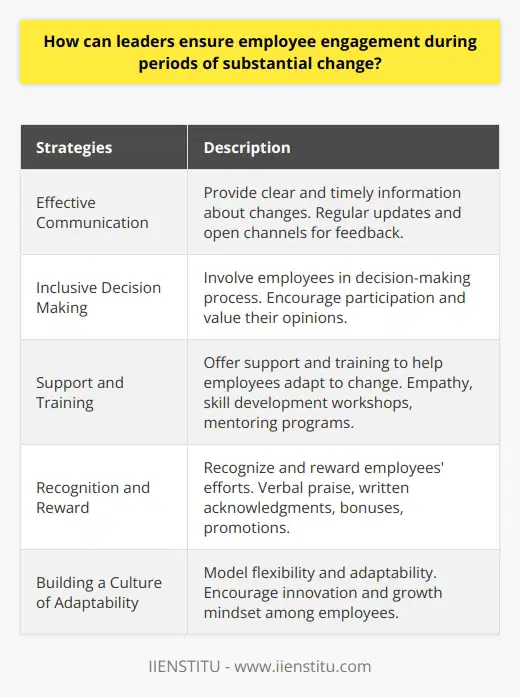
What role do organizational values and mission play in facilitating acceptance of change and minimizing resistance?
Role of Organizational Values in Facilitating Acceptance
Organizational values play a crucial role in shaping employee behavior and attitudes towards change. A shared understanding of these values helps create an environment of trust and openness, which is crucial for promoting adaptability and flexibility. Employees who feel connected to their organization's values may exhibit greater willingness to adapt to new situations, and thus demonstrate a greater acceptance of change.
Mission Impact on Minimizing Resistance
An organization's mission provides a clear sense of direction and purpose for its employees. When change initiatives align with the overarching mission, employees are more likely to recognize the importance of the change, and perceive it as beneficial for achieving organizational goals. This can reduce resistance to change by clarifying the connection between individual efforts and organizational success.
Encouraging Communication and Collaboration
Organizational values and mission also promote a culture of open communication and collaboration. Employees need to feel heard and involved in the decision-making process, which can alleviate their anxieties and uncertainties about change. By promoting dialogue and addressing concerns, organizations can foster a climate of trust and shared commitment that is most conducive to reaching consensus and embracing new ways of working.
Alignment with Employee Personal Values
Organizational values and mission may also facilitate the acceptance of change by resonating with employees' personal values. When employees perceive their values as aligned with those of the organization, they are more likely to be intrinsically motivated and committed to the success of the organization, thus reducing reluctance and resistance to change.
In conclusion, an organization's values and mission are fundamental for facilitating acceptance of change and minimizing resistance among employees. By cultivating a culture that embraces shared values, open communication, and collaboration, organizations can effectively overcome resistance to change and ensure the successful implementation of their change initiatives.
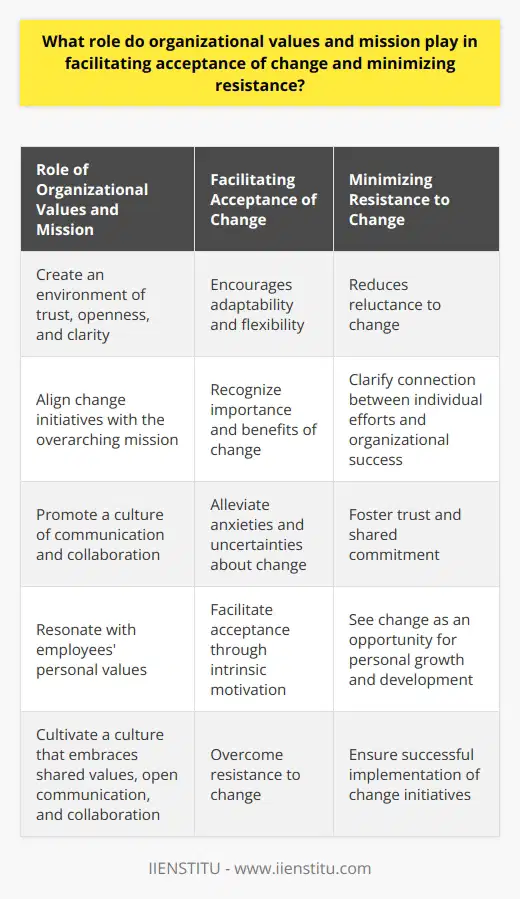
What are the key steps in implementing a successful change management process to minimize resistance and foster buy-in among employees?
Understanding Stakeholders' Perspective
To implement a successful change management process, the first key step is to understand the stakeholders' perspectives. Employees, as primary stakeholders, have a critical role in the change process. A deep understanding of their needs, fears, expectations, and attitudes towards change can elevate the success chances.
Developing a Clear and Comprehensive Plan
Secondly, develop a clear and comprehensive plan for change. This plan should outline the objectives, steps, milestones, potential challenges, and solutions. An inclusive plan not only increases transparency but also acts as a roadmap for executing the change process effectively.
Fostering Transparent and Open Communication
The third step involves fostering open and transparent communication. Regularly communicate with your employees about the change, its benefits, potential challenges, and the overall plan. Transparency helps in alleviating fears, reducing resistance and establishing clear expectations.
Engaging Employees throughout the Process
Engagement is another critical step. Include employees in the decision-making process. Evaluate their suggestions and incorporate feasible ones. This approach creates a sense of ownership among employees, leading to reduced resistance and increased buy-in.
Providing Training and Support
Finally, provide necessary training and support to employees. This will help them acquire new skills and adapt to the change. Additionally, continuous support during this transition phase can improve their morale and decrease the likelihood of resistance.
Monitoring and Feedback
Constant monitoring and feedback form the last step. Continually assess the effectiveness of the change, adjusting plans if necessary. Regular feedback enables faster problem-solving and keeps employees engaged. Ultimately, this will ensure the smooth implementation of changes, fostering employee buy-in and reducing resistance.
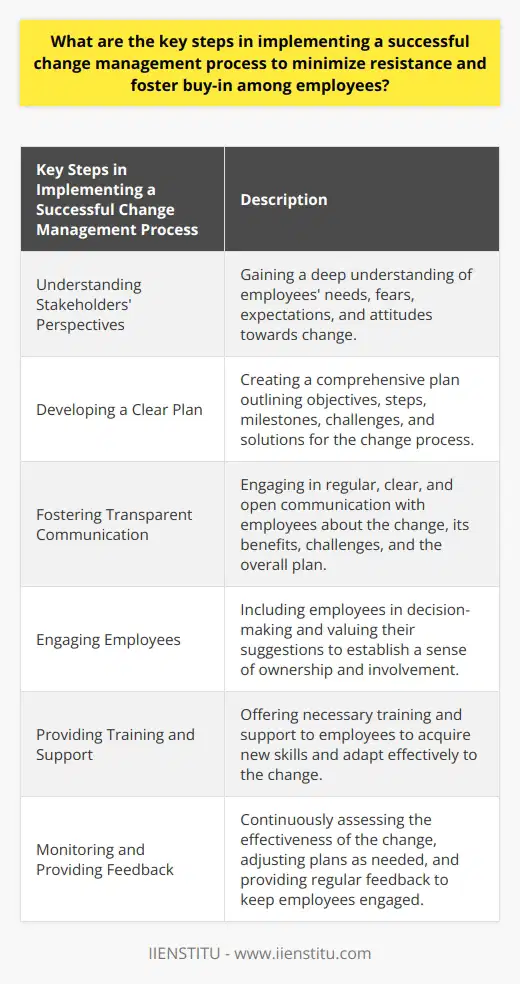
How can identifying and addressing the sources of resistance to change improve the overall change management process?
Identifying Resistance Sources
Identifying the sources of resistance to change is pivotal in honing the change management process. Resistance typically occurs due to uncertainty or fear evoked by a change. Given change is inevitable in any organization, it is crucial to anticipate and address these resistance sources.
Addressing Resistance
Addressing resistance involves acknowledging employee concerns, providing proper communication about the change, and involving them in decision-making. This promotes trust, motivates them for change and prevents miscommunication. It ensures transparency and allows a better understanding of change impacts.
Improving Change Management
A focused approach on resistance management not only alleviates employee anxiety but also significantly improves the overall change management process. It helps in reducing risk, increasing change acceptance, and implementing change efficiently. Systematic execution can foster smoother transitions and resilient organizational culture. Additionally, it promotes a strategic approach, vital for organizational success.
Employee Engagements
Employee engagement is a key indicator of the change implementation effectiveness. Thus, addressing individual reservations and doubts can encourage employees' acceptance. Their acceptance is a pivotal linchpin in driving organizational change management.
Lessons from Resistance
Resistance to change is not an adversary, but a valuable tool. It offers insights into the organization's current dynamics and potential leanings towards specific changes. This insight provides valuable feedback for developing better change strategies in the future.
Conclusion
Hence, identifying and addressing the sources of resistance to change not only improves operational efficiency but also enriches the workforce's responsiveness towards change. This proactive approach cultivates a more flexible, adaptable, and robust organization that can easily navigate the ever-changing business landscape.
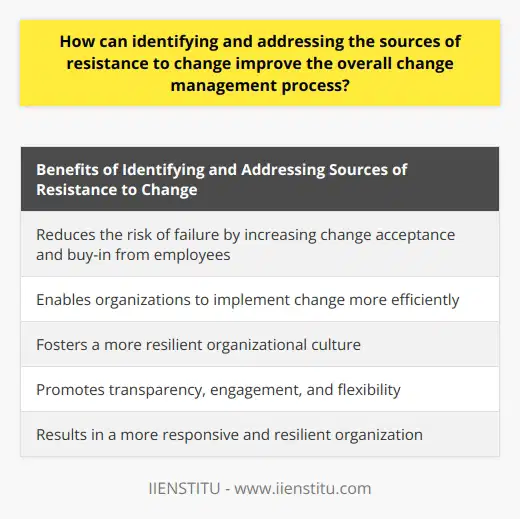
In the context of change management, how can organizations utilize both internal and external resources to successfully navigate resistance and achieve organizational objectives?
Leveraging Internal Resources
Recognition and utilization of internal resources provide key strategies in managing change resistance. Employees comprehend the workings of the organization, making them vital assets. They provide an understanding of the organization's culture and processes, allowing the change team to tailor suitable strategies. Training sessions for existing staff foster skill development to enhance their ability to adapt to the change. Open communication channels encourage feedback on changes, promoting a sense of ownership that eases resistance.
Utilizing External Resources
External resources, such as consultants and experts, can offer deeper insights into change management. They bring diverse experiences, providing fresh perspectives on transformation. Their outsider status avoids internal biases to foster objective evaluation. They can introduce market best practices to navigate change resistance, promoting acceptability and compliance. Moreover, third-party organizations can offer innovative technological solutions, which can facilitate smoother transitions.
Achieving Organizational Objectives
Effective use of these resources lays the groundwork for achieving organizational objectives. A meticulously planned approach that harnesses both internal and external strengths can propel the organization toward its goals. This strategy drives employee engagement, thereby fostering buy-in from all levels. As the acceptance of change grows, the organization moves closer to its intended objectives. Hence, organizations can overcome resistance, foster innovation, and ultimately, achieve their organizational objectives through judicious use of both internal and external resources.

What are the strategies for overcoming resistance to change?
Strategies for Addressing Resistance to Change
Employees often resist change due to fear of the unknown. One key strategy to overcome this is effective communication. Leaders must clearly articulate why the change is occurring and how benefits outweigh potential risks. This way, employees feel included in the process and are more likely to support the change.
Involve Employees in the Change Process
Another strategy involves including employees in the change process. Their involvement diminishes feelings of powerlessness and encourages a positive view of the shift. Moreover, gathering input leads to a better-informed final decision.
Training: Skilling for the Future
Providing adequate training further mitigates resistance. When employees understand the practicalities of the change, they feel more confident and less threatened. Such training fosters a culture of adaptation and capacity building.
Leveraging Role Models
Role models significantly influence adaptation to change. Leaders must demonstrate support for the change to reflect a positive outlook. Seeing leaders embrace change motivates employees to follow.
Facilitative Support
Lastly, providing facilitative support helps overcome resistance. This includes providing resources, setting realistic expectations, and acknowledging the challenges of adapting to change. With these strategies, leaders create an environment where change becomes less daunting and more inspiring to employees.

What drives resistance to change and how can these underlying factors be addressed to foster a more receptive environment for new initiatives?
Underlying Causes of Resistance
Resistance to change is often a natural response from individuals who feel threatened or uncomfortable with new scenarios or environments. Several factors can drive this resistance. The first is fear of the unknown where individuals resist because they fear the repercussions of such changes. Secondly, people might resist due to lack of trust in leadership. If they do not believe in the abilities of their leaders to successfully implement change, resistance is almost certain. Lastly, the comfort in the familiar plays a crucial role in many people's reluctance to embrace change.
Addressing the Fear of the Unknown
Addressing the fear of the unknown requires leaders to communicate effectively and transparently about the changes. Informative sessions, workshops, and seminars on new developments can provide stakeholders with clarity and reduce their anxiety about the unknown. Transparency fosters trust and can thus significantly lower resistance.
Increasing Trust in Leadership
To increase trust in leadership, leaders should involve all stakeholders in the decision-making process as much as possible. Sharing the reasons behind the proposed changes and soliciting feedback can increase stakeholders' trust and reduce resistance. Also, demonstrating a strong commitment to the change can convince others of its necessity.
Creating Comfort with Change
Finally, leaders should strive to make the transition to new initiatives as smooth as possible. They should provide training and support to help stakeholders adjust to new procedures or environments. Offering reassurances and rewards can also help individuals shift from the familiar and feel more comfortable about upcoming changes.
In conclusion, creating a receptive environment for new initiatives is about understanding the causes of resistance and strategically addressing them. This approach fosters an open, transparent culture where change is not a threat, but an opportunity for improvement and growth.
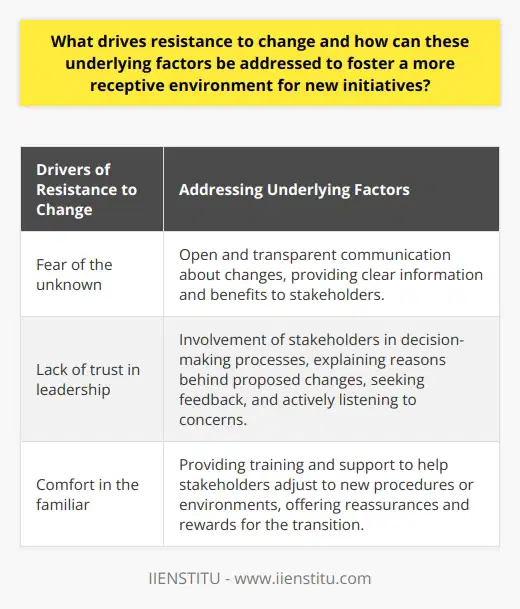
How do you effectively drive change or transformation within a team while maintaining strong engagement and motivation among team members?
Understanding Change Drivers
Driving change within a team effectively involves understanding the drivers for change. Know the purpose and objectives. Be clear about the reasons for the change.
Creating a Vision
Develop a compelling vision for the change. Envision the desired future. A clear vision can inspire, motivate and guide the team through the change process.
Communicating the Vision
Communicate the vision consistently and often. Explain what the change means for each team member. Clear, regular and honest communication helps in enhancing motivation and engagement.
Empowering Team Members
Empower team members to act on the vision by removing barriers. Encourage their contribution to the change process. Empowering team members can lead to a sense of ownership, nurturing motivation and engagement.
Celebrating Achievements
Celebrate short-term wins and recognise team members' contributions. Recognition and celebration instil a sense of accomplishment. This motivates the team to push forward.
Remaining Flexible
Remain flexible and adaptable during the change process. Be responsive to feedback and adjust plans if needed. This shows respect for team members' opinions and cultivates engagement.
Promoting Continuous Learning
Promote an atmosphere of continuous learning. Regularly provide development opportunities. Cultivating a learning environment fosters engagement as it equips team members with the skills to navigate change.
In conclusion, effectively driving change or transformation in a team while maintaining strong engagement and motivation among team members requires a well-articulated vision, regular communication, empowerment, recognition, flexibility, and continuous learning.
